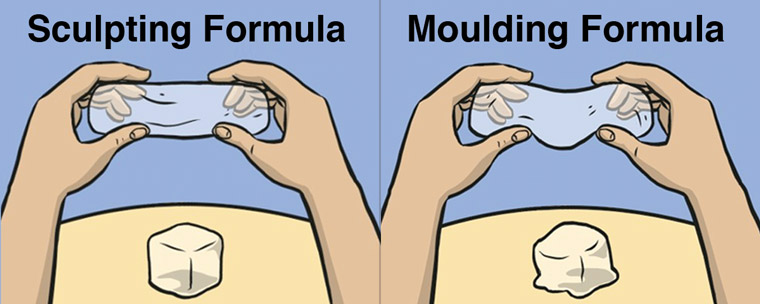Properties
Sculpting Formula or Moulding Formula?
Two different types of Plastimake are now available:
- Sculpting Formula is perfect for sculpting items with your bare hands.
- Moulding Formula is perfect for making moulds and casting into moulds.
Both formulas are identical at room temperature. However when heated to 60°C they have slightly different properties:
- Plastimake Sculpting Formula remains quite firm so it won't slump while you sculpt it.
- Plastimake Moulding Formula becomes quite soft so you can easily push it into moulds.

What does Plastimake stick to?
Plastimake won't stick to most metal, glass, porcelain, ceramic or teflon surfaces.
Plastimake will stick to some Plastics and other materials. If you're not sure, test a small piece of Plastimake first.
Plastimake gets stickier as it gets hotter, if you heat Plastimake up a lot, it may stick to unexpected things. If you don't want Plastimake to stick, let it cool a little, or apply some vaseline or oil to the other surface.
If it looks like you've accidentally stuck Plastimake to something you shouldn't have, wait until it cools before attempting to remove it. Plastimake will easily peel away from many surfaces once it has cooled.
How long does Plastimake last?
Plastimake is biodegradable, which is great for the environment, but it also means it won't last forever.
Depending on where it is kept, Plastimake will start to deteriorate after approximately 10 years. It's a slow process, over time your Plastimake item will gradually lose its strength and become brittle.
If your Plastimake project is exposed to ongoing moisture or sunlight it may show signs of ageing even earlier. However, if you keep your project indoors it could last for a lot longer.
Because Plastimake is biodegradable, we don't recommend you use it on any mission-critical, long-term projects, especially if they will be exposed to the elements.
How runny is Plastimake?
Plastimake can be made slightly runnier (less viscous) by heating it to 70° or 80°C. Of course, hotter Plastimake will be more difficult to handle with your bare hands, and may even cause burns. Be careful.
Even really hot Plastimake won't easily pour like a liquid. Instead of pouring it into a mould, you will need to push it in with your hands. See our section on using Plastimake in moulds for more information.
When not to use Plastimake
In an Australian summer the interior of your car will get hotter than 60°C (140°F), and your Plastimake item will melt.
For this reason, we recommend you don't use Plastimake on any project that will end up inside your car.
